Release 2 (9.0.2)
Part Number A95926-02
Home |
Solution Area |
Contents |
Index |
| Oracle9i Application Server Concepts Release 2 (9.0.2) Part Number A95926-02 |
|
This chapter provides an overview of Oracle9iAS Wireless features and benefits. The topics include:
After you build a J2EE application and publish it to a Web service, you can link it to any system in the back end. Then, you can aggregate this application into a portal. Now, you want to get wireless access into it. It is basically the same kind of content. Oracle9iAS Wireless lets you rapidly extend access to any existing application to any mobile device including Web-enabled phones, personal digital assistants, pagers, and even ordinary telephones through voice recognition.
Oracle9iAS Wireless is a portal service for delivering information and applications to mobile devices.
Oracle9iAS Wireless makes Web and database applications, such as e-mail, news, and directory services, accessible to mobile device users without having to rewrite content for every target platform. It converts any Internet content to XML and transforms the XML to any markup language supported by any device such as HTML, WML, HDML, VoiceXML, VoxML, and SMS.
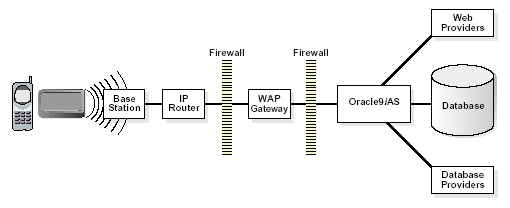
When users request wireless service, the following steps occur:
Figure 4-2 illustrates this flow in terms of the Oracle9iAS Wireless architecture.
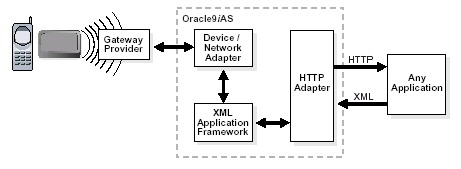
Oracle9iAS Wireless adapters pass application content to the core for processing. The HTTP Adapter retrieves content from a wide variety of sources, including existing Web sites, databases, existing applications and legacy systems.
The HTTP Adapter can securely access any content from any source that outputs XML. To render an application to any device, a developer points the HTTP Adapter to the application with a URL. The Oracle9iAS Wireless core then processes the XML object and delivers the result of the query to the wireless device, such as a WAP device.
Oracle9iAS Wireless device transformers convert the XML received from the HTTP adapter to the markup language appropriate for the requesting wireless device.
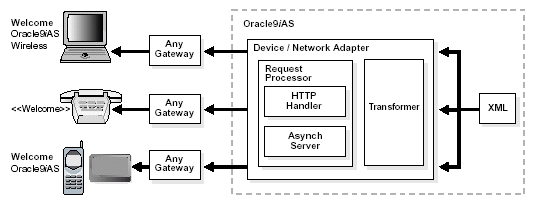
The Device/Network Adapter automatically transforms and optimizes the application content for any wireless device and network. It supports the following mobile technologies:
Oracle9iAS Wireless provides two types of transformers:
Oracle9iAS Wireless contains two parts: Core and Services.
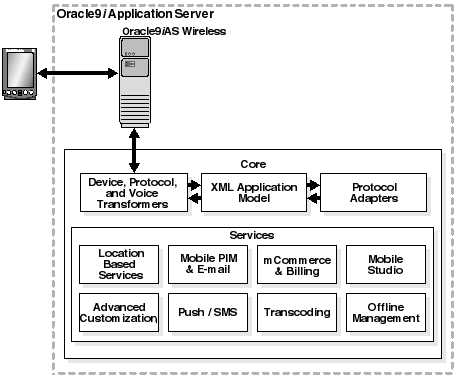
Oracle9iAS Wireless includes a core component that manages the Oracle9iAS Wireless repository and service requests:
Oracle9iAS Wireless includes services that enhance applications and simplify mobile application development:
Oracle9iAS Wireless allows you to write your applications once for any protocol, device, or network. The Oracle9iAS Wireless simplifies the design of your applications and decreases the software life-cycle time.
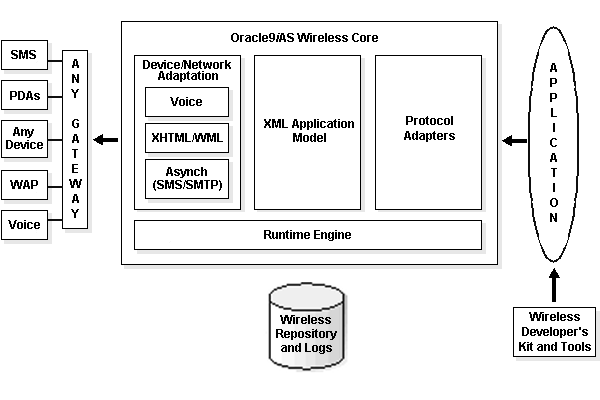
Oracle9iAS Wireless has XML, HTTP, and J2EE adapters to make existing applications portable to mobile devices. You can receive any information via a standard protocol. You can also apply transforms using XML, and then depending upon what device you are going to or what network you are going over, Oracle9iAS Wireless adapts the content to go out. Regardless of data presentation or storage format, Oracle9iAS Wireless adapts and transforms complicated content into the markup language of any wireless device.
Oracle9iAS Wireless content adapters can adapt information to the wireless Internet from a wide variety of sources, including existing Web sites, databases, and legacy systems. The goal of adapters is to create MobileXML, an Oracle XML document type definition (DTD). MobileXML is the device-independent XML for delivering content through Oracle9iAS Wireless. MobileXML elements provide the user interface elements necessary to present content to mobile devices. You can create MobileXML through standard text editors or any popular development tool that is capable of outputting XML. The specific markup language supported by that device to which the MobileXML is transformed determines the specific appearance of each MobileXML element on a device.
With Oracle9iAS Wireless, you can create location-aware applications and extend them with geographic coding, routing, mapping, and positioning functions.
Oracle9iAS Wireless enables you to assign a location to a service, making the service location-based. It supports two types of location-based services:
In addition, Oracle9iAS Wireless renders mapping services from third-party providers without you having to write custom interfaces for each service.
Oracle9iAS Wireless includes application modules that add the functionality necessary to successfully deploy applications and portals. The modules are built on open standards and focus on reusability and flexibility for seamless integration. These modules are reusable applications that you can link to existing applications.
Oracle9iAS Wireless provides several modules that are ready for deployment, including Personal Information Management (PIM) tools such as calendar, address book, fax, and mail. Some of the modules are:
Oracle9iAS Wireless PIM Service allows you to integrate corporate e-mail, directory, address book, calendaring, and instant messaging applications into your mobile enterprise portals. Each of these applications is built as a module that can be called either directly by mobile users from their devices, or by other applications. In addition, they are fully integrated. You can access features such as directory or address book-based recipient selection while composing e-mail messages.
You can leverage from Oracle9iAS Wireless PIM Service modules to:
The Mobile E-mail Client provides access from any mobile devices to any IMAP or POP3 server. This includes such servers as Microsoft Exchange and Lotus Domino.
The Mobile Directory Client connects to any LDAP directory server. Finally, the Mobile Calendar Client integrates natively with Exchange and Lotus Servers, and through published interfaces enables easy customization to support any Calendar Server.
Oracle m-Commerce Service is a set of Oracle9iAS Wireless modules that:
You can build your m-Commerce application using Oracle9iAS Wireless. You can incorporate any m-Commerce component by adding URL links to the modules complying with their APIs. If you already have an m-Commerce application developed in WML, you can run it through the XLtor module by calling its API, and providing your application's URL. This action will add links from your application to all m-Commerce modules.
Mobile Wallet module (m-Wallet) provides a convenient single-click commerce payment mechanism. It is a server side, encrypted entity that contains a payment instrument, identification and address information for registered users. m-Wallet enables users to store all the information required to fill out commerce-related forms from any application. That information is used to complete transactions, and through APIs built and maintained by authorized third-party service providers, can be made available to authorized partners and e-merchants.
The power of the m-Wallet is that it securely stores this information for users, providing them an easy, secure shopping experience, and freeing them from repeatedly entering information.
FormFiller module dynamically saves and maintains mappings among e-commerce applications' form fields and wallet elements to enable one-click shopping. Along with the XLtor, FormFiller enables these legacy applications to be integrated into mobile portals, accessed from any mobile device, and participate in wallet-enhanced commerce transactions.
Payment Processing drivers provide seamless integration with payment mechanisms such as Oracle's CRM iPayment, enabling the processing of credit card and bank account transactions via direct connections to financial networks.
The extensible architecture of the m-Commerce Service enables the development of drivers to integrate m-Commerce services with third-party applications.
OracleMobile Online Studio is an on-line developer portal for quickly building, testing, and deploying wireless applications. It lets you develop a mobile application that is immediately accessible from all devices. All you need is a standard application server that outputs XML to leverage shared online Web services to reach any wireless Web browser, any messaging device through SMS, E-Mail, WAP push, and any phone using voice.
OracleMobile Online Studio's build, test, and deploy model presents a hosted approach to developing dynamic content. You do not need to download any software or tools to start using it. It also provides you access to reusable modules and examples.
You can customize your Personalization Portal pages in several different ways. You can easily alter the appearance of logos, banners, and icons. Alternatively, you may want to create your own JSP to achieve the desired look and feel.
Users can customize or configure the following:
You can use Oracle9iAS Wireless to build notification services that alert users to important information or events. Oracle9iAS Wireless supports these notifications, or push applications, as e-mail and Short Message Service (SMS). Users can also make their own notifications without having to access the system local notifications.
In addition, you can also build location-sensitive mobile notification services that send a mobile user personalized promotional offers from stores or restaurants within the vicinity of the mobile user.
The majority of applications available on the Web render content in format specific to certain types of clients or devices. Transcoding services reformat applications developed for a particular device or markup language to formats suitable for any Web-enabled device.
Transcoding services in Oracle9iAS Wireless supports a Web Content Adaptation service and a WML Translator service.
You can off-line enable your Oracle9iAS Wireless application with Oracle9i Lite, which provides a lightweight database for off-line mobile computing. Oracle9i Lite is a platform to develop, deploy, and manage e-business applications that run locally on mobile devices. It offers the following:
|
|
 Copyright © 2002 Oracle Corporation. All Rights Reserved. |
|